Consumer Behavior: Personality & Demographics in Holiday Choice
VerifiedAdded on 2023/06/10
|9
|2486
|191
Report
AI Summary
This report delves into the consumer behavior of three individuals with varying backgrounds, financial conditions, and age groups as they decide among six holiday destinations: Spain, Italy, France, Las Vegas, New Zealand, Hong Kong, Gold Coast, and Barossa Valley. It examines how personality traits, such as extroversion, efficiency, and risk aversion, influence their preferences for different travel packages. The report also considers demographic factors like age, income, and cultural background and their impact on decision-making, particularly concerning cost and travel duration. Ultimately, the report recommends that businesses thoroughly understand their target market's behavior patterns to tailor their offerings effectively, enhance pricing transparency, and provide value-added services to attract and retain customers. The analysis highlights the importance of detailed research in understanding customer preferences and customizing product offerings for enhanced customer affinity and loyalty. Desklib provides a wide range of resources to help students with similar assignments.
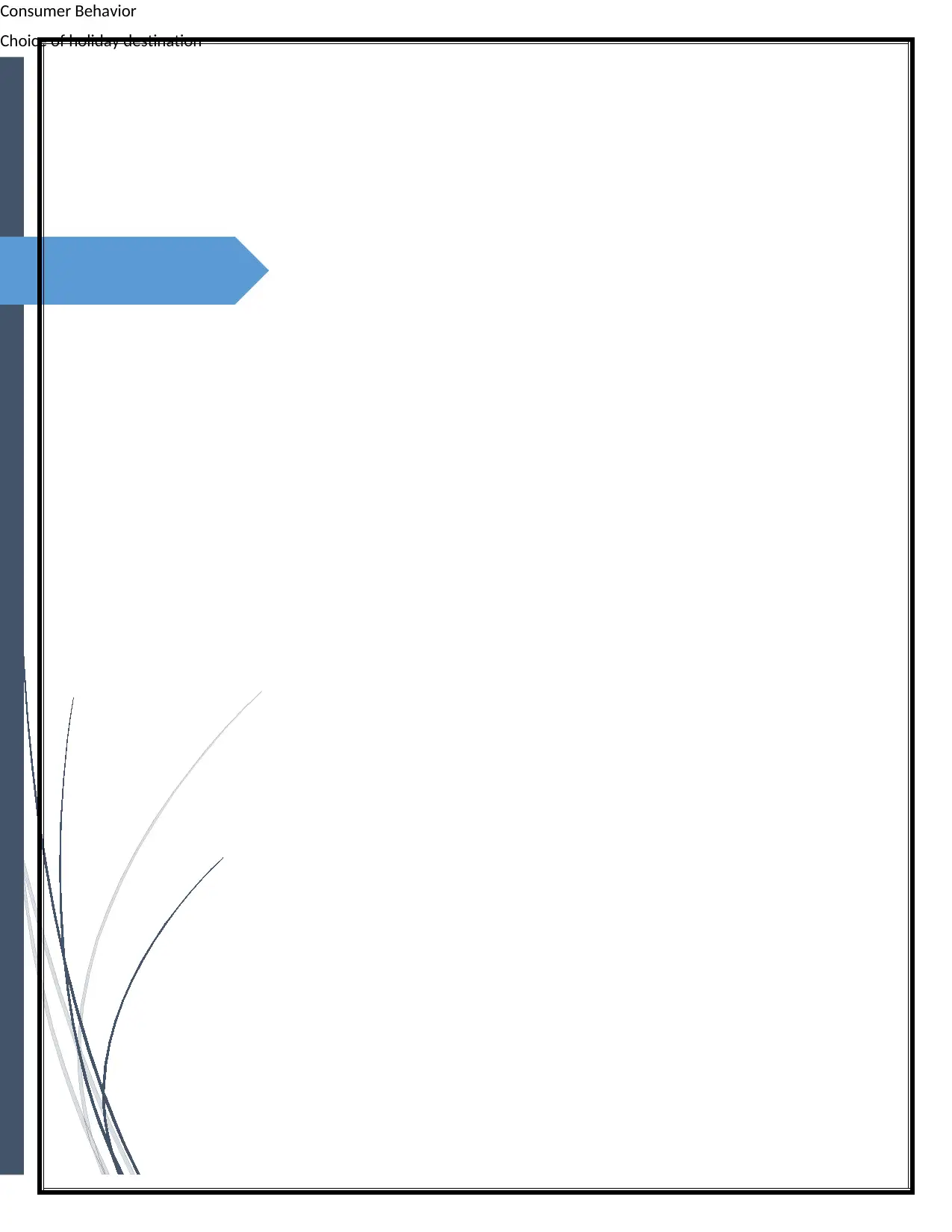
Consumer Behavior
Choice of holiday destination
Choice of holiday destination
Paraphrase This Document
Need a fresh take? Get an instant paraphrase of this document with our AI Paraphraser
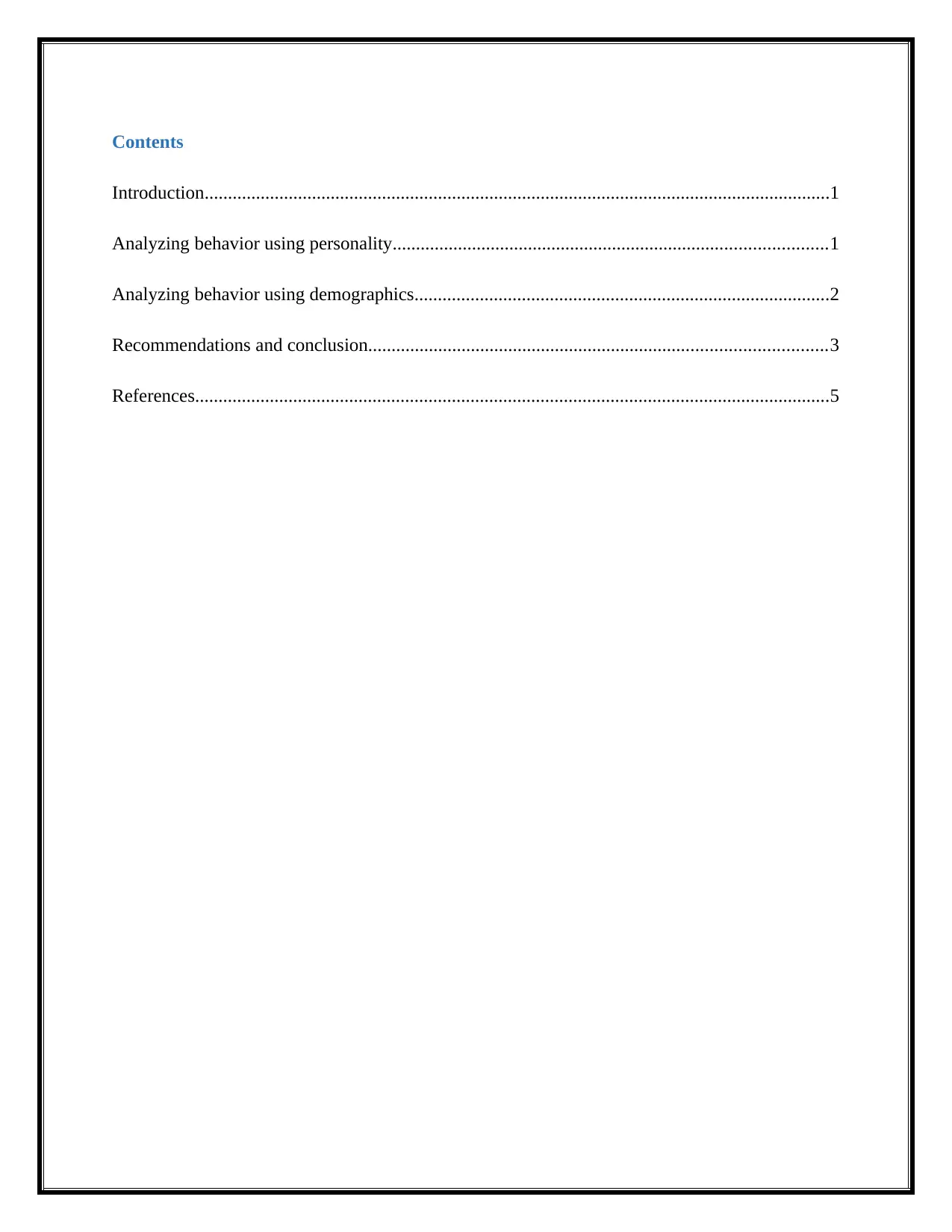
Contents
Introduction......................................................................................................................................1
Analyzing behavior using personality.............................................................................................1
Analyzing behavior using demographics.........................................................................................2
Recommendations and conclusion..................................................................................................3
References........................................................................................................................................5
Introduction......................................................................................................................................1
Analyzing behavior using personality.............................................................................................1
Analyzing behavior using demographics.........................................................................................2
Recommendations and conclusion..................................................................................................3
References........................................................................................................................................5
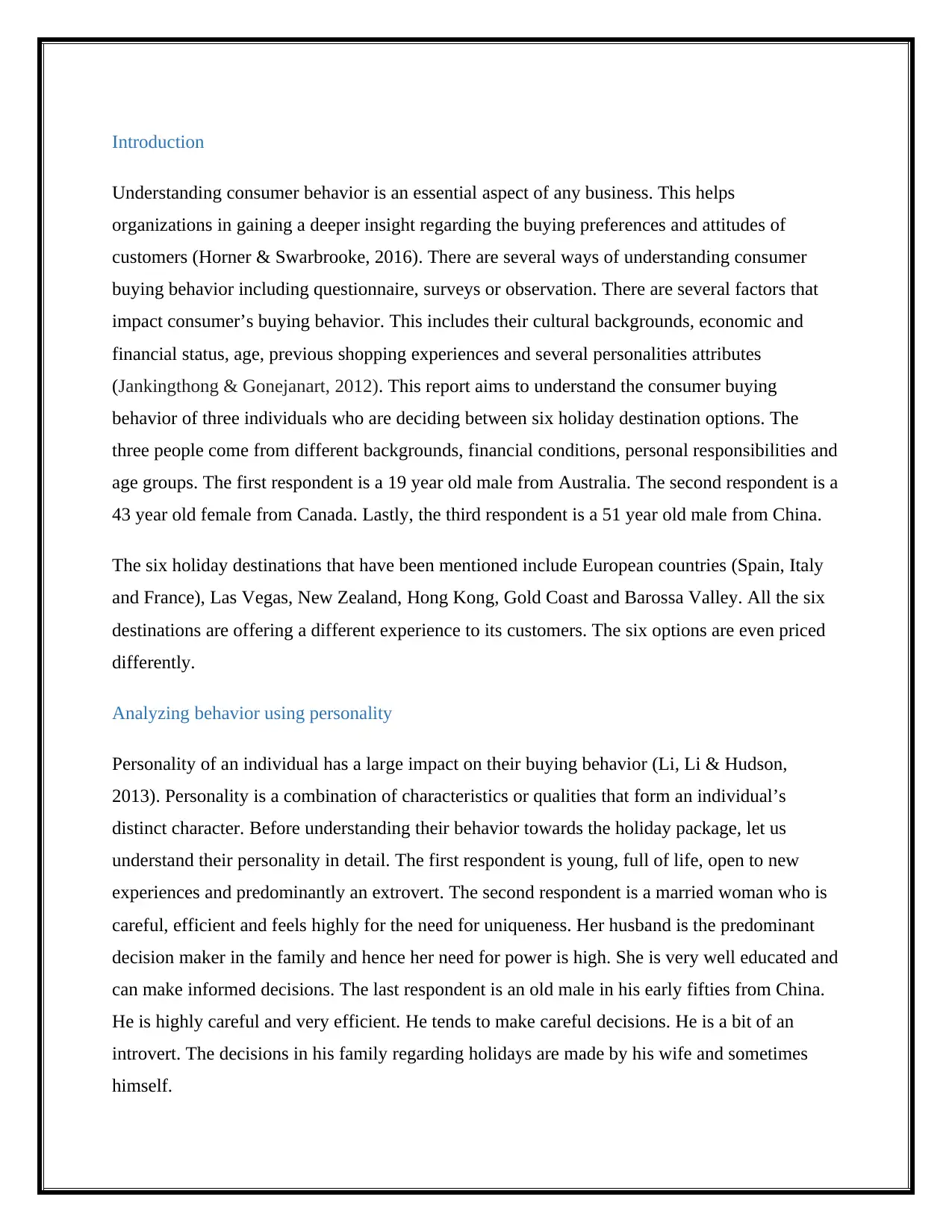
Introduction
Understanding consumer behavior is an essential aspect of any business. This helps
organizations in gaining a deeper insight regarding the buying preferences and attitudes of
customers (Horner & Swarbrooke, 2016). There are several ways of understanding consumer
buying behavior including questionnaire, surveys or observation. There are several factors that
impact consumer’s buying behavior. This includes their cultural backgrounds, economic and
financial status, age, previous shopping experiences and several personalities attributes
(Jankingthong & Gonejanart, 2012). This report aims to understand the consumer buying
behavior of three individuals who are deciding between six holiday destination options. The
three people come from different backgrounds, financial conditions, personal responsibilities and
age groups. The first respondent is a 19 year old male from Australia. The second respondent is a
43 year old female from Canada. Lastly, the third respondent is a 51 year old male from China.
The six holiday destinations that have been mentioned include European countries (Spain, Italy
and France), Las Vegas, New Zealand, Hong Kong, Gold Coast and Barossa Valley. All the six
destinations are offering a different experience to its customers. The six options are even priced
differently.
Analyzing behavior using personality
Personality of an individual has a large impact on their buying behavior (Li, Li & Hudson,
2013). Personality is a combination of characteristics or qualities that form an individual’s
distinct character. Before understanding their behavior towards the holiday package, let us
understand their personality in detail. The first respondent is young, full of life, open to new
experiences and predominantly an extrovert. The second respondent is a married woman who is
careful, efficient and feels highly for the need for uniqueness. Her husband is the predominant
decision maker in the family and hence her need for power is high. She is very well educated and
can make informed decisions. The last respondent is an old male in his early fifties from China.
He is highly careful and very efficient. He tends to make careful decisions. He is a bit of an
introvert. The decisions in his family regarding holidays are made by his wife and sometimes
himself.
Understanding consumer behavior is an essential aspect of any business. This helps
organizations in gaining a deeper insight regarding the buying preferences and attitudes of
customers (Horner & Swarbrooke, 2016). There are several ways of understanding consumer
buying behavior including questionnaire, surveys or observation. There are several factors that
impact consumer’s buying behavior. This includes their cultural backgrounds, economic and
financial status, age, previous shopping experiences and several personalities attributes
(Jankingthong & Gonejanart, 2012). This report aims to understand the consumer buying
behavior of three individuals who are deciding between six holiday destination options. The
three people come from different backgrounds, financial conditions, personal responsibilities and
age groups. The first respondent is a 19 year old male from Australia. The second respondent is a
43 year old female from Canada. Lastly, the third respondent is a 51 year old male from China.
The six holiday destinations that have been mentioned include European countries (Spain, Italy
and France), Las Vegas, New Zealand, Hong Kong, Gold Coast and Barossa Valley. All the six
destinations are offering a different experience to its customers. The six options are even priced
differently.
Analyzing behavior using personality
Personality of an individual has a large impact on their buying behavior (Li, Li & Hudson,
2013). Personality is a combination of characteristics or qualities that form an individual’s
distinct character. Before understanding their behavior towards the holiday package, let us
understand their personality in detail. The first respondent is young, full of life, open to new
experiences and predominantly an extrovert. The second respondent is a married woman who is
careful, efficient and feels highly for the need for uniqueness. Her husband is the predominant
decision maker in the family and hence her need for power is high. She is very well educated and
can make informed decisions. The last respondent is an old male in his early fifties from China.
He is highly careful and very efficient. He tends to make careful decisions. He is a bit of an
introvert. The decisions in his family regarding holidays are made by his wife and sometimes
himself.
⊘ This is a preview!⊘
Do you want full access?
Subscribe today to unlock all pages.

Trusted by 1+ million students worldwide
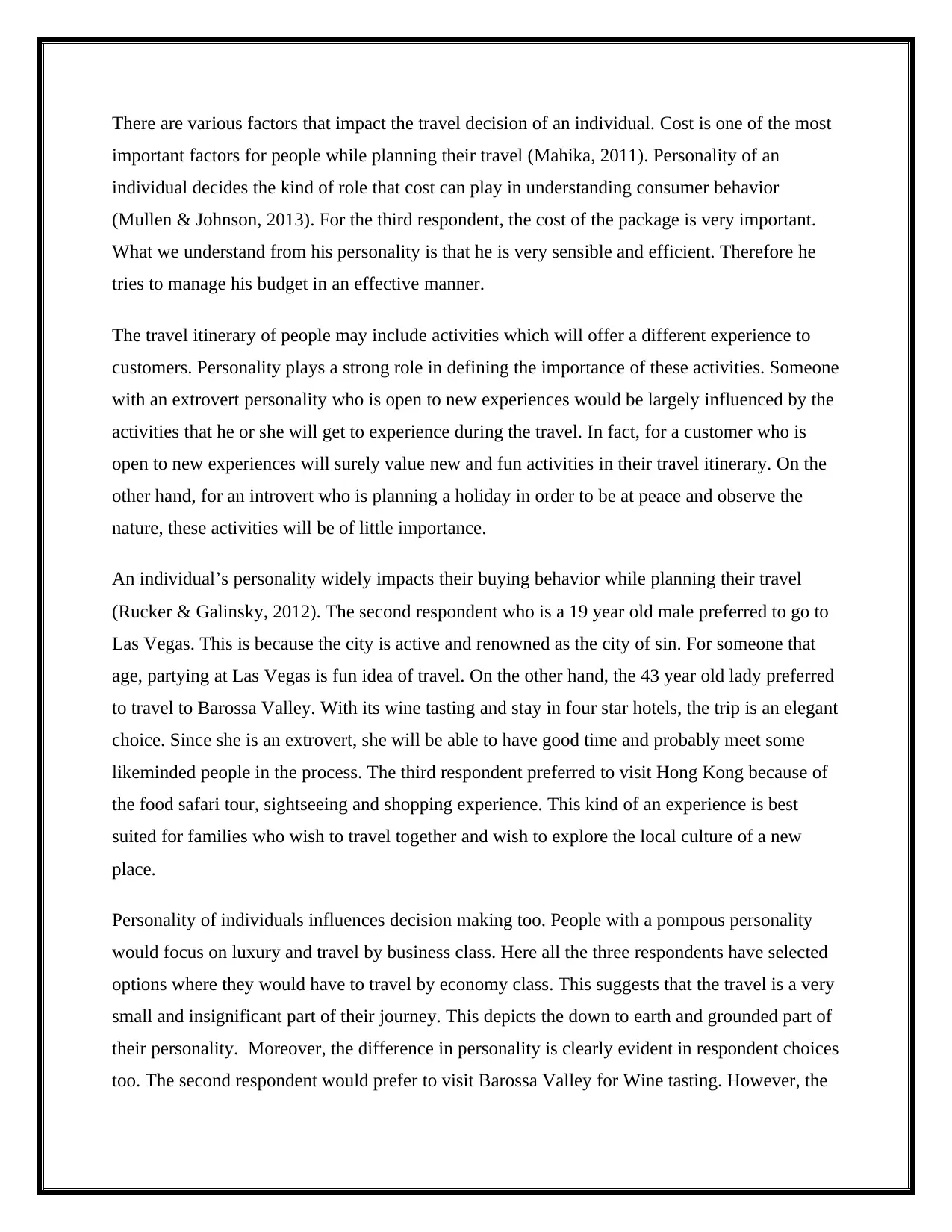
There are various factors that impact the travel decision of an individual. Cost is one of the most
important factors for people while planning their travel (Mahika, 2011). Personality of an
individual decides the kind of role that cost can play in understanding consumer behavior
(Mullen & Johnson, 2013). For the third respondent, the cost of the package is very important.
What we understand from his personality is that he is very sensible and efficient. Therefore he
tries to manage his budget in an effective manner.
The travel itinerary of people may include activities which will offer a different experience to
customers. Personality plays a strong role in defining the importance of these activities. Someone
with an extrovert personality who is open to new experiences would be largely influenced by the
activities that he or she will get to experience during the travel. In fact, for a customer who is
open to new experiences will surely value new and fun activities in their travel itinerary. On the
other hand, for an introvert who is planning a holiday in order to be at peace and observe the
nature, these activities will be of little importance.
An individual’s personality widely impacts their buying behavior while planning their travel
(Rucker & Galinsky, 2012). The second respondent who is a 19 year old male preferred to go to
Las Vegas. This is because the city is active and renowned as the city of sin. For someone that
age, partying at Las Vegas is fun idea of travel. On the other hand, the 43 year old lady preferred
to travel to Barossa Valley. With its wine tasting and stay in four star hotels, the trip is an elegant
choice. Since she is an extrovert, she will be able to have good time and probably meet some
likeminded people in the process. The third respondent preferred to visit Hong Kong because of
the food safari tour, sightseeing and shopping experience. This kind of an experience is best
suited for families who wish to travel together and wish to explore the local culture of a new
place.
Personality of individuals influences decision making too. People with a pompous personality
would focus on luxury and travel by business class. Here all the three respondents have selected
options where they would have to travel by economy class. This suggests that the travel is a very
small and insignificant part of their journey. This depicts the down to earth and grounded part of
their personality. Moreover, the difference in personality is clearly evident in respondent choices
too. The second respondent would prefer to visit Barossa Valley for Wine tasting. However, the
important factors for people while planning their travel (Mahika, 2011). Personality of an
individual decides the kind of role that cost can play in understanding consumer behavior
(Mullen & Johnson, 2013). For the third respondent, the cost of the package is very important.
What we understand from his personality is that he is very sensible and efficient. Therefore he
tries to manage his budget in an effective manner.
The travel itinerary of people may include activities which will offer a different experience to
customers. Personality plays a strong role in defining the importance of these activities. Someone
with an extrovert personality who is open to new experiences would be largely influenced by the
activities that he or she will get to experience during the travel. In fact, for a customer who is
open to new experiences will surely value new and fun activities in their travel itinerary. On the
other hand, for an introvert who is planning a holiday in order to be at peace and observe the
nature, these activities will be of little importance.
An individual’s personality widely impacts their buying behavior while planning their travel
(Rucker & Galinsky, 2012). The second respondent who is a 19 year old male preferred to go to
Las Vegas. This is because the city is active and renowned as the city of sin. For someone that
age, partying at Las Vegas is fun idea of travel. On the other hand, the 43 year old lady preferred
to travel to Barossa Valley. With its wine tasting and stay in four star hotels, the trip is an elegant
choice. Since she is an extrovert, she will be able to have good time and probably meet some
likeminded people in the process. The third respondent preferred to visit Hong Kong because of
the food safari tour, sightseeing and shopping experience. This kind of an experience is best
suited for families who wish to travel together and wish to explore the local culture of a new
place.
Personality of individuals influences decision making too. People with a pompous personality
would focus on luxury and travel by business class. Here all the three respondents have selected
options where they would have to travel by economy class. This suggests that the travel is a very
small and insignificant part of their journey. This depicts the down to earth and grounded part of
their personality. Moreover, the difference in personality is clearly evident in respondent choices
too. The second respondent would prefer to visit Barossa Valley for Wine tasting. However, the
Paraphrase This Document
Need a fresh take? Get an instant paraphrase of this document with our AI Paraphraser
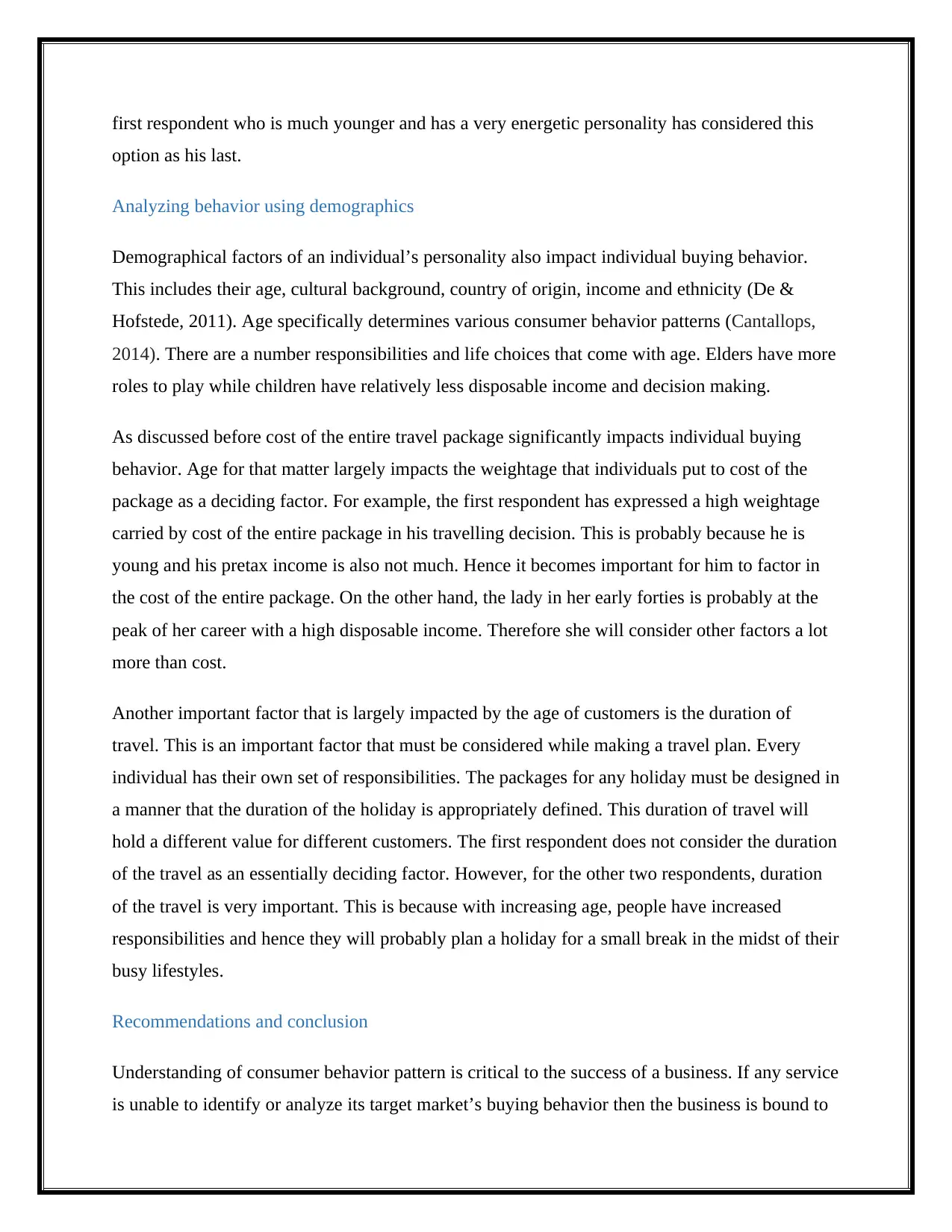
first respondent who is much younger and has a very energetic personality has considered this
option as his last.
Analyzing behavior using demographics
Demographical factors of an individual’s personality also impact individual buying behavior.
This includes their age, cultural background, country of origin, income and ethnicity (De &
Hofstede, 2011). Age specifically determines various consumer behavior patterns (Cantallops,
2014). There are a number responsibilities and life choices that come with age. Elders have more
roles to play while children have relatively less disposable income and decision making.
As discussed before cost of the entire travel package significantly impacts individual buying
behavior. Age for that matter largely impacts the weightage that individuals put to cost of the
package as a deciding factor. For example, the first respondent has expressed a high weightage
carried by cost of the entire package in his travelling decision. This is probably because he is
young and his pretax income is also not much. Hence it becomes important for him to factor in
the cost of the entire package. On the other hand, the lady in her early forties is probably at the
peak of her career with a high disposable income. Therefore she will consider other factors a lot
more than cost.
Another important factor that is largely impacted by the age of customers is the duration of
travel. This is an important factor that must be considered while making a travel plan. Every
individual has their own set of responsibilities. The packages for any holiday must be designed in
a manner that the duration of the holiday is appropriately defined. This duration of travel will
hold a different value for different customers. The first respondent does not consider the duration
of the travel as an essentially deciding factor. However, for the other two respondents, duration
of the travel is very important. This is because with increasing age, people have increased
responsibilities and hence they will probably plan a holiday for a small break in the midst of their
busy lifestyles.
Recommendations and conclusion
Understanding of consumer behavior pattern is critical to the success of a business. If any service
is unable to identify or analyze its target market’s buying behavior then the business is bound to
option as his last.
Analyzing behavior using demographics
Demographical factors of an individual’s personality also impact individual buying behavior.
This includes their age, cultural background, country of origin, income and ethnicity (De &
Hofstede, 2011). Age specifically determines various consumer behavior patterns (Cantallops,
2014). There are a number responsibilities and life choices that come with age. Elders have more
roles to play while children have relatively less disposable income and decision making.
As discussed before cost of the entire travel package significantly impacts individual buying
behavior. Age for that matter largely impacts the weightage that individuals put to cost of the
package as a deciding factor. For example, the first respondent has expressed a high weightage
carried by cost of the entire package in his travelling decision. This is probably because he is
young and his pretax income is also not much. Hence it becomes important for him to factor in
the cost of the entire package. On the other hand, the lady in her early forties is probably at the
peak of her career with a high disposable income. Therefore she will consider other factors a lot
more than cost.
Another important factor that is largely impacted by the age of customers is the duration of
travel. This is an important factor that must be considered while making a travel plan. Every
individual has their own set of responsibilities. The packages for any holiday must be designed in
a manner that the duration of the holiday is appropriately defined. This duration of travel will
hold a different value for different customers. The first respondent does not consider the duration
of the travel as an essentially deciding factor. However, for the other two respondents, duration
of the travel is very important. This is because with increasing age, people have increased
responsibilities and hence they will probably plan a holiday for a small break in the midst of their
busy lifestyles.
Recommendations and conclusion
Understanding of consumer behavior pattern is critical to the success of a business. If any service
is unable to identify or analyze its target market’s buying behavior then the business is bound to
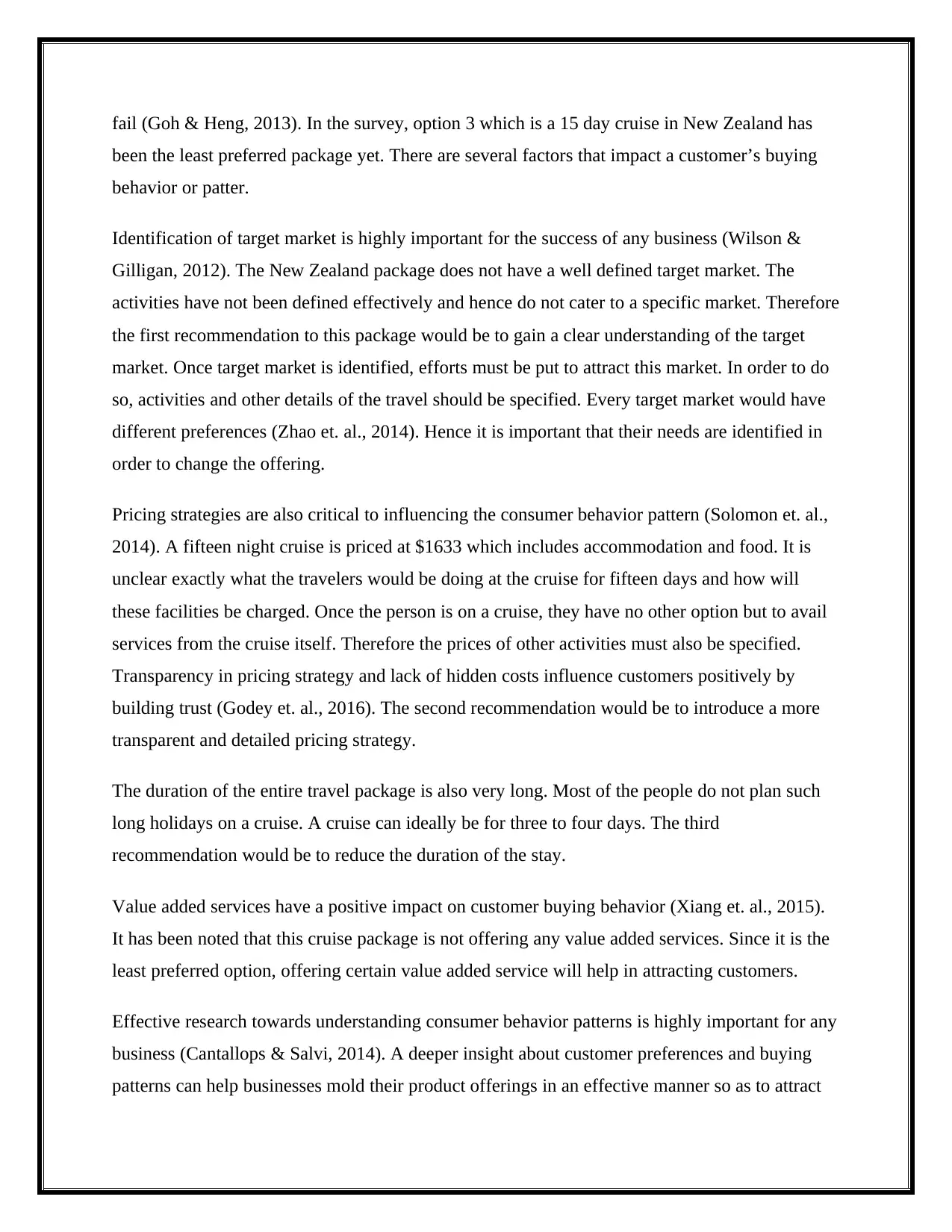
fail (Goh & Heng, 2013). In the survey, option 3 which is a 15 day cruise in New Zealand has
been the least preferred package yet. There are several factors that impact a customer’s buying
behavior or patter.
Identification of target market is highly important for the success of any business (Wilson &
Gilligan, 2012). The New Zealand package does not have a well defined target market. The
activities have not been defined effectively and hence do not cater to a specific market. Therefore
the first recommendation to this package would be to gain a clear understanding of the target
market. Once target market is identified, efforts must be put to attract this market. In order to do
so, activities and other details of the travel should be specified. Every target market would have
different preferences (Zhao et. al., 2014). Hence it is important that their needs are identified in
order to change the offering.
Pricing strategies are also critical to influencing the consumer behavior pattern (Solomon et. al.,
2014). A fifteen night cruise is priced at $1633 which includes accommodation and food. It is
unclear exactly what the travelers would be doing at the cruise for fifteen days and how will
these facilities be charged. Once the person is on a cruise, they have no other option but to avail
services from the cruise itself. Therefore the prices of other activities must also be specified.
Transparency in pricing strategy and lack of hidden costs influence customers positively by
building trust (Godey et. al., 2016). The second recommendation would be to introduce a more
transparent and detailed pricing strategy.
The duration of the entire travel package is also very long. Most of the people do not plan such
long holidays on a cruise. A cruise can ideally be for three to four days. The third
recommendation would be to reduce the duration of the stay.
Value added services have a positive impact on customer buying behavior (Xiang et. al., 2015).
It has been noted that this cruise package is not offering any value added services. Since it is the
least preferred option, offering certain value added service will help in attracting customers.
Effective research towards understanding consumer behavior patterns is highly important for any
business (Cantallops & Salvi, 2014). A deeper insight about customer preferences and buying
patterns can help businesses mold their product offerings in an effective manner so as to attract
been the least preferred package yet. There are several factors that impact a customer’s buying
behavior or patter.
Identification of target market is highly important for the success of any business (Wilson &
Gilligan, 2012). The New Zealand package does not have a well defined target market. The
activities have not been defined effectively and hence do not cater to a specific market. Therefore
the first recommendation to this package would be to gain a clear understanding of the target
market. Once target market is identified, efforts must be put to attract this market. In order to do
so, activities and other details of the travel should be specified. Every target market would have
different preferences (Zhao et. al., 2014). Hence it is important that their needs are identified in
order to change the offering.
Pricing strategies are also critical to influencing the consumer behavior pattern (Solomon et. al.,
2014). A fifteen night cruise is priced at $1633 which includes accommodation and food. It is
unclear exactly what the travelers would be doing at the cruise for fifteen days and how will
these facilities be charged. Once the person is on a cruise, they have no other option but to avail
services from the cruise itself. Therefore the prices of other activities must also be specified.
Transparency in pricing strategy and lack of hidden costs influence customers positively by
building trust (Godey et. al., 2016). The second recommendation would be to introduce a more
transparent and detailed pricing strategy.
The duration of the entire travel package is also very long. Most of the people do not plan such
long holidays on a cruise. A cruise can ideally be for three to four days. The third
recommendation would be to reduce the duration of the stay.
Value added services have a positive impact on customer buying behavior (Xiang et. al., 2015).
It has been noted that this cruise package is not offering any value added services. Since it is the
least preferred option, offering certain value added service will help in attracting customers.
Effective research towards understanding consumer behavior patterns is highly important for any
business (Cantallops & Salvi, 2014). A deeper insight about customer preferences and buying
patterns can help businesses mold their product offerings in an effective manner so as to attract
⊘ This is a preview!⊘
Do you want full access?
Subscribe today to unlock all pages.

Trusted by 1+ million students worldwide
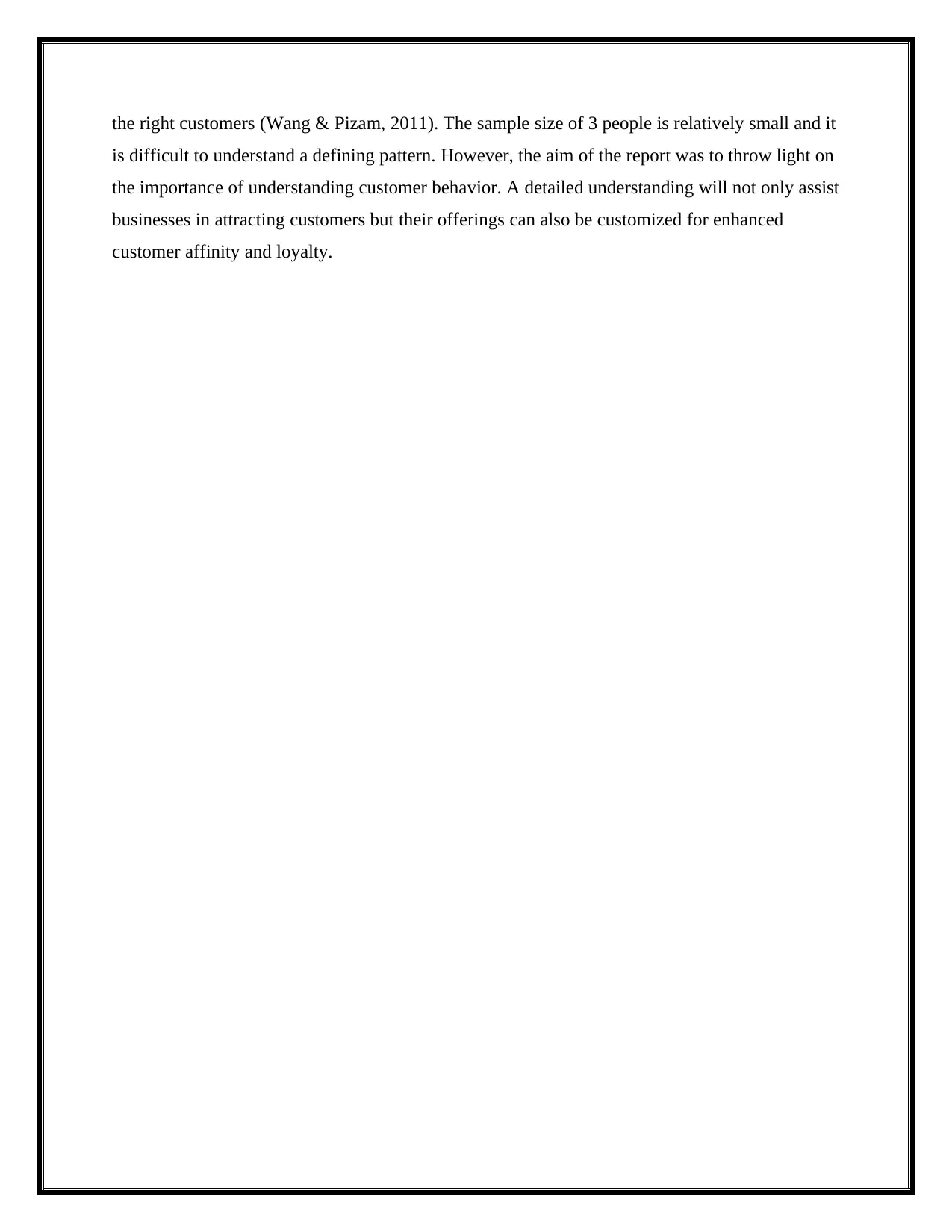
the right customers (Wang & Pizam, 2011). The sample size of 3 people is relatively small and it
is difficult to understand a defining pattern. However, the aim of the report was to throw light on
the importance of understanding customer behavior. A detailed understanding will not only assist
businesses in attracting customers but their offerings can also be customized for enhanced
customer affinity and loyalty.
is difficult to understand a defining pattern. However, the aim of the report was to throw light on
the importance of understanding customer behavior. A detailed understanding will not only assist
businesses in attracting customers but their offerings can also be customized for enhanced
customer affinity and loyalty.
Paraphrase This Document
Need a fresh take? Get an instant paraphrase of this document with our AI Paraphraser
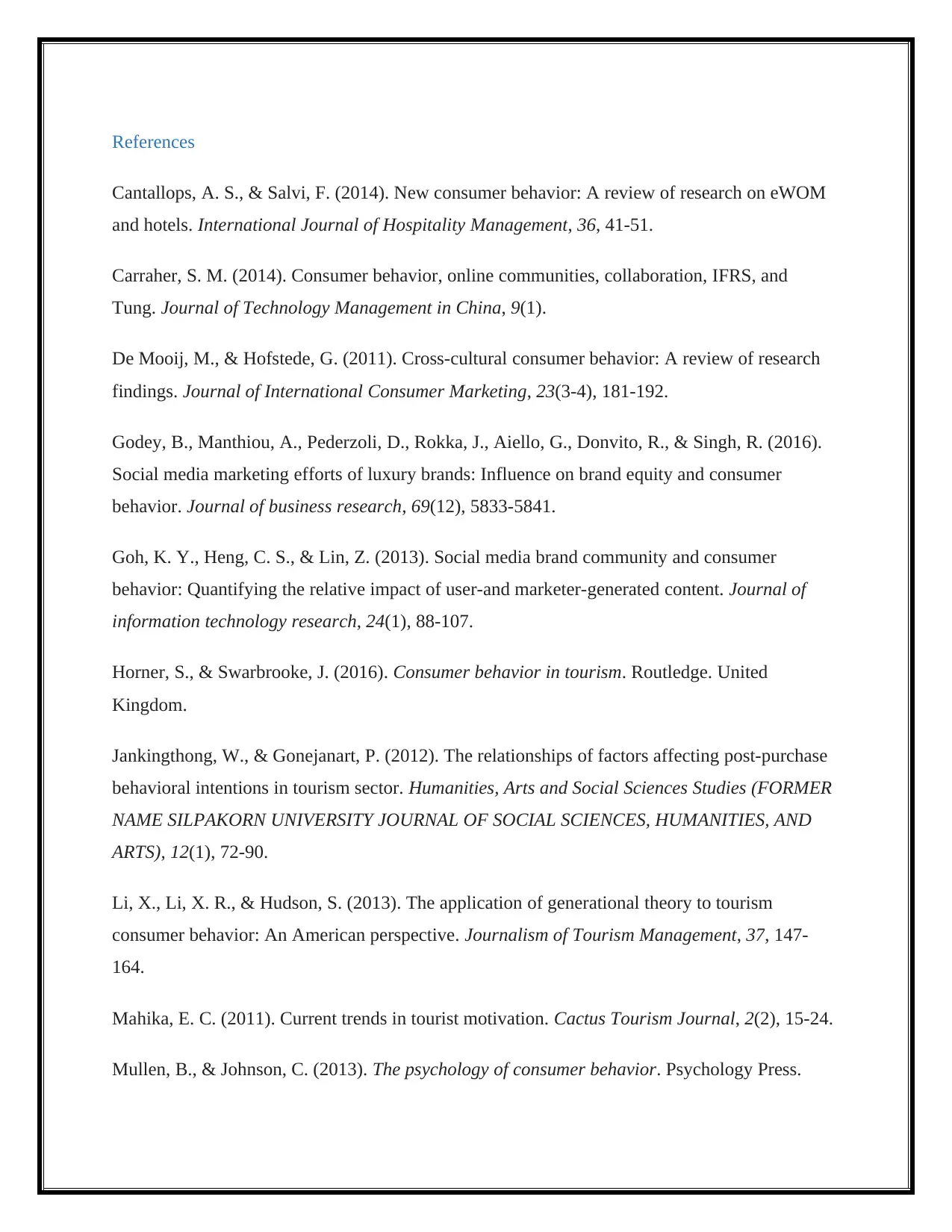
References
Cantallops, A. S., & Salvi, F. (2014). New consumer behavior: A review of research on eWOM
and hotels. International Journal of Hospitality Management, 36, 41-51.
Carraher, S. M. (2014). Consumer behavior, online communities, collaboration, IFRS, and
Tung. Journal of Technology Management in China, 9(1).
De Mooij, M., & Hofstede, G. (2011). Cross-cultural consumer behavior: A review of research
findings. Journal of International Consumer Marketing, 23(3-4), 181-192.
Godey, B., Manthiou, A., Pederzoli, D., Rokka, J., Aiello, G., Donvito, R., & Singh, R. (2016).
Social media marketing efforts of luxury brands: Influence on brand equity and consumer
behavior. Journal of business research, 69(12), 5833-5841.
Goh, K. Y., Heng, C. S., & Lin, Z. (2013). Social media brand community and consumer
behavior: Quantifying the relative impact of user-and marketer-generated content. Journal of
information technology research, 24(1), 88-107.
Horner, S., & Swarbrooke, J. (2016). Consumer behavior in tourism. Routledge. United
Kingdom.
Jankingthong, W., & Gonejanart, P. (2012). The relationships of factors affecting post-purchase
behavioral intentions in tourism sector. Humanities, Arts and Social Sciences Studies (FORMER
NAME SILPAKORN UNIVERSITY JOURNAL OF SOCIAL SCIENCES, HUMANITIES, AND
ARTS), 12(1), 72-90.
Li, X., Li, X. R., & Hudson, S. (2013). The application of generational theory to tourism
consumer behavior: An American perspective. Journalism of Tourism Management, 37, 147-
164.
Mahika, E. C. (2011). Current trends in tourist motivation. Cactus Tourism Journal, 2(2), 15-24.
Mullen, B., & Johnson, C. (2013). The psychology of consumer behavior. Psychology Press.
Cantallops, A. S., & Salvi, F. (2014). New consumer behavior: A review of research on eWOM
and hotels. International Journal of Hospitality Management, 36, 41-51.
Carraher, S. M. (2014). Consumer behavior, online communities, collaboration, IFRS, and
Tung. Journal of Technology Management in China, 9(1).
De Mooij, M., & Hofstede, G. (2011). Cross-cultural consumer behavior: A review of research
findings. Journal of International Consumer Marketing, 23(3-4), 181-192.
Godey, B., Manthiou, A., Pederzoli, D., Rokka, J., Aiello, G., Donvito, R., & Singh, R. (2016).
Social media marketing efforts of luxury brands: Influence on brand equity and consumer
behavior. Journal of business research, 69(12), 5833-5841.
Goh, K. Y., Heng, C. S., & Lin, Z. (2013). Social media brand community and consumer
behavior: Quantifying the relative impact of user-and marketer-generated content. Journal of
information technology research, 24(1), 88-107.
Horner, S., & Swarbrooke, J. (2016). Consumer behavior in tourism. Routledge. United
Kingdom.
Jankingthong, W., & Gonejanart, P. (2012). The relationships of factors affecting post-purchase
behavioral intentions in tourism sector. Humanities, Arts and Social Sciences Studies (FORMER
NAME SILPAKORN UNIVERSITY JOURNAL OF SOCIAL SCIENCES, HUMANITIES, AND
ARTS), 12(1), 72-90.
Li, X., Li, X. R., & Hudson, S. (2013). The application of generational theory to tourism
consumer behavior: An American perspective. Journalism of Tourism Management, 37, 147-
164.
Mahika, E. C. (2011). Current trends in tourist motivation. Cactus Tourism Journal, 2(2), 15-24.
Mullen, B., & Johnson, C. (2013). The psychology of consumer behavior. Psychology Press.
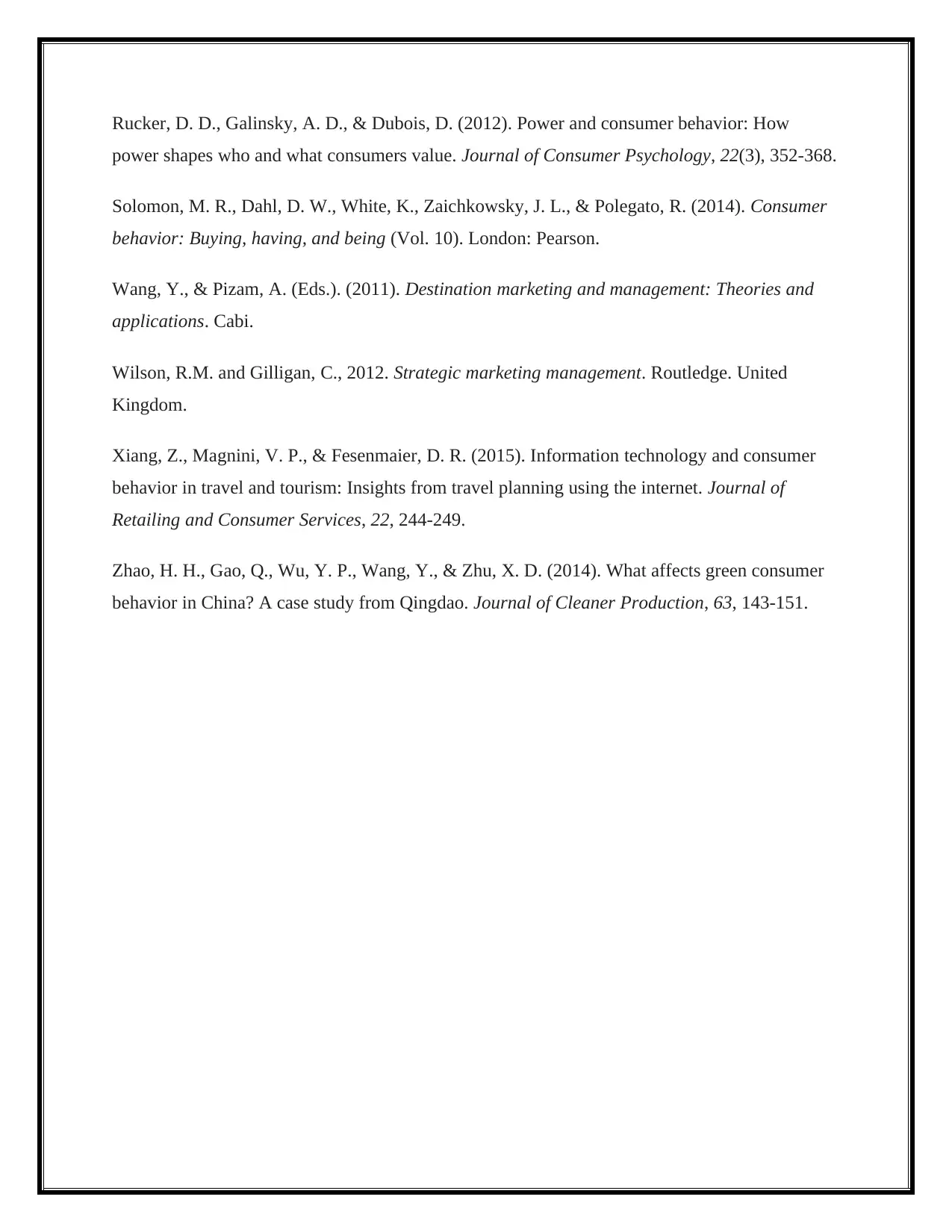
Rucker, D. D., Galinsky, A. D., & Dubois, D. (2012). Power and consumer behavior: How
power shapes who and what consumers value. Journal of Consumer Psychology, 22(3), 352-368.
Solomon, M. R., Dahl, D. W., White, K., Zaichkowsky, J. L., & Polegato, R. (2014). Consumer
behavior: Buying, having, and being (Vol. 10). London: Pearson.
Wang, Y., & Pizam, A. (Eds.). (2011). Destination marketing and management: Theories and
applications. Cabi.
Wilson, R.M. and Gilligan, C., 2012. Strategic marketing management. Routledge. United
Kingdom.
Xiang, Z., Magnini, V. P., & Fesenmaier, D. R. (2015). Information technology and consumer
behavior in travel and tourism: Insights from travel planning using the internet. Journal of
Retailing and Consumer Services, 22, 244-249.
Zhao, H. H., Gao, Q., Wu, Y. P., Wang, Y., & Zhu, X. D. (2014). What affects green consumer
behavior in China? A case study from Qingdao. Journal of Cleaner Production, 63, 143-151.
power shapes who and what consumers value. Journal of Consumer Psychology, 22(3), 352-368.
Solomon, M. R., Dahl, D. W., White, K., Zaichkowsky, J. L., & Polegato, R. (2014). Consumer
behavior: Buying, having, and being (Vol. 10). London: Pearson.
Wang, Y., & Pizam, A. (Eds.). (2011). Destination marketing and management: Theories and
applications. Cabi.
Wilson, R.M. and Gilligan, C., 2012. Strategic marketing management. Routledge. United
Kingdom.
Xiang, Z., Magnini, V. P., & Fesenmaier, D. R. (2015). Information technology and consumer
behavior in travel and tourism: Insights from travel planning using the internet. Journal of
Retailing and Consumer Services, 22, 244-249.
Zhao, H. H., Gao, Q., Wu, Y. P., Wang, Y., & Zhu, X. D. (2014). What affects green consumer
behavior in China? A case study from Qingdao. Journal of Cleaner Production, 63, 143-151.
⊘ This is a preview!⊘
Do you want full access?
Subscribe today to unlock all pages.

Trusted by 1+ million students worldwide
1 out of 9
Related Documents
Your All-in-One AI-Powered Toolkit for Academic Success.
+13062052269
info@desklib.com
Available 24*7 on WhatsApp / Email
![[object Object]](/_next/static/media/star-bottom.7253800d.svg)
Unlock your academic potential
Copyright © 2020–2025 A2Z Services. All Rights Reserved. Developed and managed by ZUCOL.





